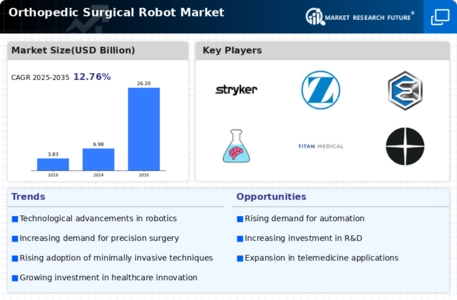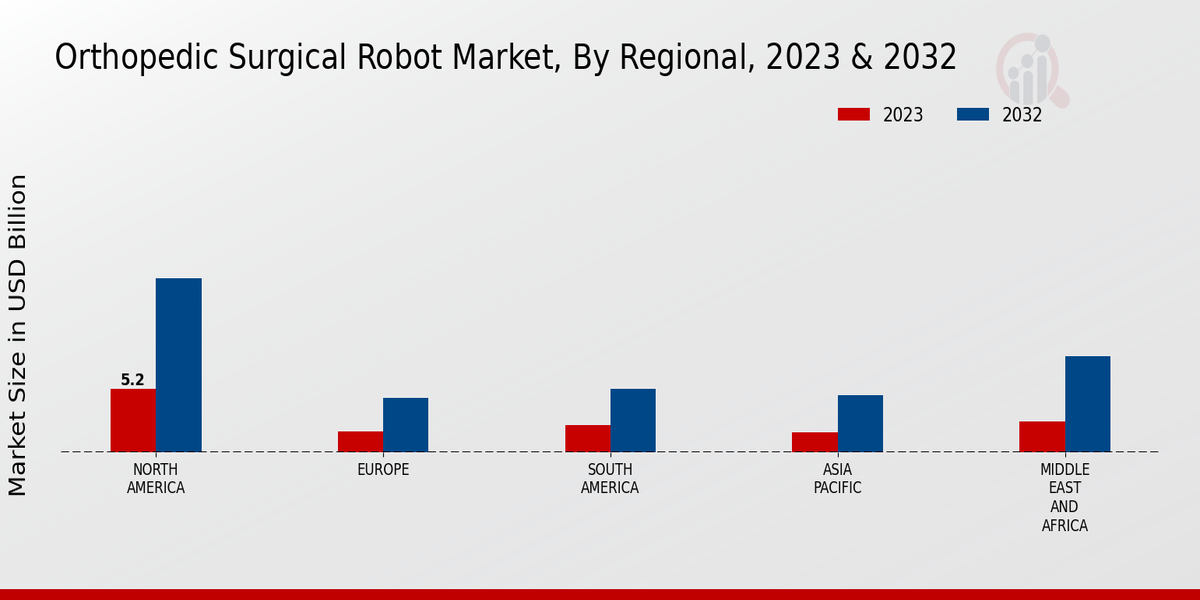Market Growth Projections
The Global Orthopedic Surgical Robot Market Industry is projected to experience substantial growth over the next decade. With a market value of 6.98 USD Billion in 2024, it is expected to expand to 26.2 USD Billion by 2035. This growth trajectory indicates a compound annual growth rate (CAGR) of 12.77% from 2025 to 2035. Such projections reflect the increasing integration of robotic technologies in orthopedic surgeries, driven by factors such as technological advancements, rising orthopedic disorders, and the demand for minimally invasive procedures. The market's expansion is likely to reshape the landscape of orthopedic surgery, enhancing patient outcomes and surgical efficiencies.
Technological Advancements
The Global Orthopedic Surgical Robot Market Industry is experiencing rapid growth due to continuous technological advancements. Innovations in robotic systems, such as enhanced imaging capabilities and artificial intelligence integration, are improving surgical precision and outcomes. For instance, the introduction of robotic-assisted systems allows for minimally invasive procedures, which reduce recovery times and hospital stays. As a result, hospitals are increasingly adopting these technologies to enhance their surgical offerings. The market is projected to reach 6.98 USD Billion in 2024, indicating a strong demand for advanced surgical solutions that improve patient care and operational efficiency.
Rising Incidence of Orthopedic Disorders
The Global Orthopedic Surgical Robot Market Industry is driven by the rising incidence of orthopedic disorders, including osteoarthritis and sports-related injuries. As populations age and physical activity levels increase, the demand for orthopedic surgeries is expected to rise significantly. This trend is particularly evident in developed regions where healthcare access is improving. The increasing number of joint replacement surgeries, which often utilize robotic assistance, underscores the need for advanced surgical technologies. With the market projected to grow to 26.2 USD Billion by 2035, addressing these orthopedic challenges through robotic solutions is becoming increasingly critical.
Increased Investment in Healthcare Infrastructure
The Global Orthopedic Surgical Robot Market Industry benefits from increased investment in healthcare infrastructure, particularly in emerging economies. Governments and private sectors are recognizing the importance of advanced surgical technologies in improving healthcare outcomes. This investment is leading to the establishment of state-of-the-art surgical centers equipped with robotic systems. For example, countries in Asia and Latin America are expanding their healthcare facilities to include robotic-assisted surgeries, thereby enhancing their surgical capabilities. This trend is likely to contribute to the projected CAGR of 12.77% from 2025 to 2035, reflecting a growing commitment to modernizing healthcare.
Surge in Demand for Minimally Invasive Procedures
The Global Orthopedic Surgical Robot Market Industry is witnessing a surge in demand for minimally invasive procedures, which are associated with reduced patient recovery times and lower complication rates. Robotic systems facilitate these procedures by providing surgeons with enhanced dexterity and precision. As patients increasingly prefer less invasive options, hospitals are adopting robotic technologies to meet this demand. This shift not only improves patient satisfaction but also optimizes surgical workflows. The anticipated growth in the market, reaching 6.98 USD Billion in 2024, highlights the importance of robotic solutions in addressing the evolving preferences of patients and healthcare providers.
Growing Awareness and Acceptance of Robotic Surgery
The Global Orthopedic Surgical Robot Market Industry is experiencing growing awareness and acceptance of robotic surgery among both healthcare professionals and patients. Educational initiatives and successful case studies are helping to demystify robotic-assisted procedures, leading to increased trust in these technologies. As more surgeons become trained in robotic techniques, the adoption rate is likely to rise. This trend is particularly evident in regions where healthcare systems are investing in training programs and resources. The positive outcomes associated with robotic surgeries are further encouraging acceptance, suggesting a robust future for the market as it continues to evolve.




















